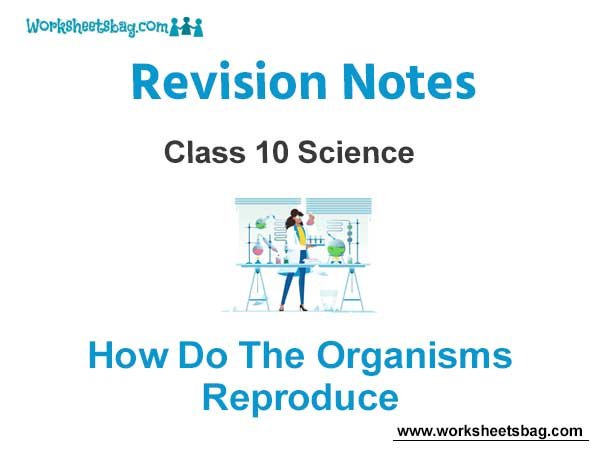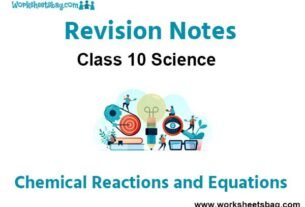Please refer to the How do the Organisms Reproduce Revision Notes given below. These revision notes have been designed as per the latest NCERT, CBSE and KVS books issued for the current academic year. Students will be able to understand the entire chapter in your class 10th Science book. We have provided chapter wise Notes for Class 10 Science as per the latest examination pattern.
Revision Notes Chapter 8 How do the Organisms Reproduce
Students of Class 10 Science will be able to revise the entire chapter and also learn all important concepts based on the topic wise notes given below. Our best teachers for Grade 10 have prepared these to help you get better marks in upcoming examinations. These revision notes cover all important topics given in this chapter.
REPRODUCTION
Reproduction is an integral feature of all living beings. The process by which a living being produces its own like is called reproduction.
IMPORTANCE OF REPRODUCTION:
Reproduction is important for each species, because this is the only way for a living being to continue its lineage. Apart from being important for a particular individual, reproduction is also important for the whole ecosystem. Reproduction helps in maintaining a proper balance among various biotic constituents of the ecosystem. Moreover, reproduction also facilitates evolution because variations come through reproduction; over several generations.
TYPES OF REPRODUCTION:
There are two main types, viz. asexual and sexual reproduction.
- Asexual Reproduction: When a single parent is involved and no gamete formation takes place; the method is called asexual reproduction. No meiosis happens during asexual reproduction.
- Sexual Reproduction: When two parents are involved and gamete formation takes; the method is called sexual reproduction. Meiosis happens during gamete formation; which is an important step of sexual reproduction.
Question. What is the importance of DNA copying in reproduction?
Answer: The importance of DNA copying during reproduction is that:
(i) It is responsible for the transmission of parental characteristic to its offsprings.
(ii) It also leads to certain genetic variation.
Question. Why is variation beneficial to the species but not necessarily for the individual?
Answer: Variations allow organisms to exist in diverse habitats or niches. In the absence of variations, a species may be restricted to particular area. If this area gets drastically altered, due to various natural or man-made causes, the species may be wiped out. However, if some variations were present in a few individuals, these colonize other habitats and could survive. But if variations are present in a single organism there would be very little for it to survive.
ASEXUAL REPRODUCTION
MODES OF REPRODUCTION USED BY SINGLE ORGANISMS
Modes of reproduction involving a single parent, without involving gametes. These are known as asexual modes of reproduction Organisms can reproduce asexually in many ways. Some of them are given here.
FISSION
1. BINARY FISSION
Most of the unicellular animals prefer this method for reproduction. These organisms reproduce by binary fission; especially when conditions are favourable, i.e. adequate amount of food and moisture is available. Binary fission is somewhat similar to mitosis. The mother cell divides into two daughter cells; and each daughter cell begins its life like a new individual. The parent generation ceases to exist, after binary fission . Amoeba is a very good example of the organism which reproduces by binary fission.

2. MULTIPLE FISSION
When conditions become unfavourable, i.e. food, moisture, proper temperature, etc. are not available; this is the preferred mode of reproduction by unicellular organisms. The organism develops a thick coating around itself. This is called cyst. The cyst helps the organism to tide over the bad phase. The nucleus divides into several nuclei and each daughter nucleus is surrounded by a membrane. All metabolic activities stop in the organism, after cyst formation. When favourable conditions return, the cyst dissolves or breaks down; releasing the daughter nuclei. The daughter nuclei; in turn; grow into new individuals. Plasmodium and entamoeba undergo cyst stage, when they are not in the body of their prime host, i.e. humans.

FRAGMENTATION
In multicellular organisms with simple body organization, simple reproductive methods have been noticed. Reproduction by fragmentation is seen in filamentous algae, e.g. spirogyra. In Spirogyra algae, the plant body breaks up into smaller fragments. Each fragment grows into a new individual.

REGENERATION
If the individual is somehow cut or broken up into many pieces, many of these pieces grow into separate individuals. For example, simple animals like Hydra and Planaria can be cut into

any number of pieces and each piece grows into a complete organism. This is known as regeneration (see the below figures). Regeneration is carried out by specialised cells. These cells proliferate and make large numbers of cells.
BUDDING
Organisms such as Hydra use regenerative cells for reproduction in the process of budding. In Hydra, a bud develops as an outgrowth due to repeated cell division at one specific site (see below figure). These buds develop into tiny individuals and when fully mature, detach from the parent body and become new independent individuals.

VEGETATIVE PROPAGATION
Vegetative propagation is the ability of plants to reproduce by bringing forth new plants from existing vegetative structures without sexual reproduction. Some examples of vegetative propagation are given below.
Tuber of Potato: The potato tuber is a modified stem. Many notches can be seen on the surface of potato . These are called ‘eyes’ of potato. Each ‘eye’ of a potato can give rise to a new potato plant. Farmers utilize this capability of potatoes to grow potato more quickly; which is not possible by using the seeds of potato.

Modified roots of Carrot and Sweet Potato: Carrot and sweet potato are examples of modifications of roots; for food storage. These roots can give rise to new plants; when kept
under the soil.

Rhizomes of Ginger and Turmeric: Rhizomes are examples of modified underground stems for food storage. These contain nodes, internodes and scaly leaves. When buried under the soil, the rhizomes produce new plants.

Leaf of Bryophyllum: Leaves of bryophyllum have notches on the margin. If a leaf is put under the soil, small saplings grow from the notches on the leaf margin. (see above figure)
Artificial Vegetative Propagation: Man has used artificial vegetative propagation to grow many plants. This has enabled farmers and horticulturists to grow many plants in shorter duration and has helped them to earn more profit. Artificial vegetative propagation has also helped in developing many new varieties of plants. Stem cutting, layering and grafting are the preferred means of artificial vegetative propagation.
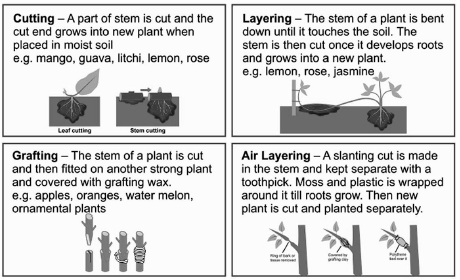
SPORE FORMATION
Rhizopus produces hundreds of microscopic reproductive units called spores. When the spore case (also called sporangium) bursts, the spores spreads into air. These air-borne spores land on food or soil, under favourable conditions like damp and warm conditions, they germinate and produce new individuals. Most of the fungi like Rhizopus, Mucor etc., Bacteria and nonflowering plants such as ferns and mosses reproduce by the method of spore formation.

ADVANTAGES OF ASEXUAL REPRODUCTION:
- The organism does not have to depend on another organism for carrying out reproduction; because a single parent is needed.
- It takes less time than sexual reproduction and hence more number of offspring can be produced in shorter time.
- The offspring are exact clones of their parent.
- Desirable characteristics can be easily incorporated into plants with artificial vegetative propagation.
DISADVANTAGES OF ASEXUAL REPRODUCTION:
- As a single parent is involved, so there is negligible chance of variation.
- In most of the cases in simple organisms, the parent generation ceases to exist after sexual reproduction.
- Asexual reproduction cannot give rise to biodiversity which is important for a healthy ecosystem.
Question. How does binary fission differ from multiple fission?
Answer:

Question. How will an organism be benefited if it reproduces through spores?
Answer: Spores are tiny, spherical, asexual reproductive bodies which under favourable conditions, like damp and warm conditions, germinate to produce new plants. They are covered by the hard protective wall, which enables the plant to survive unfavourable conditions.
Question. Can you think of reasons why more complex organisms cannot give rise to new individuals through regeneration?
Answer: Multicellular organisms cannot reproduce by cell because they are not simple random collection of cells. In them, specialised cells are organized as tissues and tissues are organised into organs, which then have to be kept at different positions in the body. Cell-by-cell division would be impractical. Multicellular organisms, therefore, require to use more complex ways of reproduction.
Moreover, simple multicellular organisms possess special type of tissues which have the potential to grow into a new organism but complex multicellular organisms have no such specialised cells.
Question. Why is vegetative propagation practised for growing some types of plants?
Answer: Vegetative propagation method is used for growing certain plants which do not produce viable seeds. It is also used for growing of plants bearing superior traits, because they produce genetically identical plants. It is also used for growing plants which require longer time to grow and become mature. Plant which require lot of care during early stages of development are also grown by this method.
Question. Why is DNA copying an essential part of the process of reproduction?
Answer: Chromosome in the nucleus of a cell contain information for inheritance of features from parent to next generation in the form of DNA. The DNA in the cell nucleus is the information source of making proteins. Therefore, a basic event in reproduction is creation of DNA copy for the next generation.
SEXUAL REPRODUCTION
SEXUAL REPRODUCTION IN PLANTS
Sexual reproduction is the process in which two components ( male and female) are involved to produce offsprings of their own kind. A bull alone cannot produce new calves. It needs a cow. Female sheep alone cannot produce new ones. It needs a male sheep.
Both the sexes, male and female, are needed to roduce new offspring.
PARTS OF A TYPICAL FLOWER
A flower is a modified shoot with a limited growth. Flowers vary in size, shape,structure and colour. The main parts of a flower are,
1. Calyx
2. Corolla
3. Androecium and
4. Gynoecium.

Androecium: Androecium is the male part of a flower,and Gynoecium is the female part.
Androecium: Androecium is a group of stamens. Each Stamen consists of a stalk called the filament and a small bag like structure called the anther at the tip. The pollen grains are contained in the anther within the pollen sacs.
Gynoecium: Gynoecium is the female part of the flower and consists of the carpels or ovary. Gynoceium has three parts
(1) Stigma
(2) Style and
(3) Ovary.
The ovary contains the ovules and each ovule carries within it an embryo sac, within which lies the egg cell or the female gamete. The sexual reproduction in flowering plants involves
1. Pollination
2. Fertilization
1. POLLINATION
Transfer of pollen grains from the anther to the stigma is called pollination. Pollen grains are transferred mainly by wind, water and insects. They are called as pollinating agents.
Pollination is the first and important event in the development of the fruit and seed. Pollination is followed by fertilization.
TYPES OF POLLINATION
Pollination is of two types. They are
1. Self pollination
2. Cross pollination
SELF POLLINATION
Self pollination is also known as autogamy. The transfer of pollen grains from the anther of a flower to the stigma of the same flower or another flower of the same plant is known as self pollination.

ADVANTAGES OF SELF POLLINATION
- Self pollination is certain in bisexual flowers.
- Flowers need not depend on agents of pollination.
- There is no wastage of pollen grains.
DISADVANTAGES OF SELF POLLINATION
- The seeds are less in number.
- Endosperm is minute. Therefore, the seeds produce weak plants.
- New varieties of plants cannot be produced resulting in the degradation of the plant.
CRO POLLINATION (ALLOGAMY)
The transfer of pollen grains of a flower to the stigma of another flower of a different plant of the same species is called cross pollination or allogamy.
ADVANTAGES OF CROSS POLLINATION
- The seeds produced as a result of cross pollination develop, germinate properly and grow into better plants, i.e., cross pollination leads to the production of new varieties.
- More viable seeds are produced.
AGENTS OF CROSS POLLINATION
In order to bring about cross pollination, it is necessary that the pollen should be carried from one flower to another of a different plant. This takes place through agency of animals, insects, wind and water.
1. Pollination by birds (Ornithophily)
2. Pollination by insects and animals
ZOOPHILY
Animals and insects – Birds, squirrels and insects are attracted to the bright petals of the flowers. These flowers are also large in size and have a sweet smell. Some of these flowers have nectar and a sweet scent. This is the most common of all methods of pollination. This kind of pollination is called Zoophily. (Pollination by animals and birds).
ANEMOPHILY (POLLINATION BY WIND)
The flowers pollinated by air are mostly small in size and without any attractive colour, smell and nectar. They produce a large number of pollen grains to make up for the wastage of pollen in times of transit.
The pollen grains are dry and powdery, and hence are easily carried by the wind. Some pollen grains even have wings. Stigmas are large and protruding, even branched and feathery.
e.g.Maize. Flowers pollinated by wind are called Anemophilous, e.g. Grass and pine.
POLLINATION BY WATER (HYDROPHILY)
This pollination takes place in water plants or plants that are adapted to water habitat. e.g. Vallisneria. This pollination is known as hydrophily. The flowers are small and inconspicuous.
FERTILIZATION
Pollination is the transfer of pollen grains from the anther to the stigma. Each pollen grain has protective walls called exine and intine. The outer wall exine is thick and it has small pores called germination pores. The inner wall is thin and elastic.
GERMINATION OF POLLEN GRAIN
If pollen grain falls on a suitable stigma, it starts germinating. A mature pollen consists of two cells. The larger one is vegetative cell and the smaller one is generative cell. The vegetative cell starts growing and emerges through the germination pore. It develops through the style as a long tube known as pollen tube. The generative cell gets into the tube and divides into two male gametes (sperms).

PROCESS OF FERTILIZATION
The pollen tube enters into the embryo sac through micropyle. At this time, the pollen tube bursts open, gametes released from the pollen tube and enter into the embryosac. One of the gametes fuses with the egg, and the other fuses with the secondary nucleus. The fusion of a male gamete with egg is known as fertilization. The fertilized egg is known as zygote which develops into embryo.
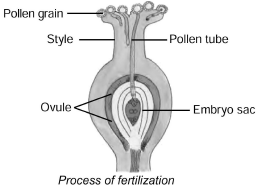
DOUBLE FERTILIZATION
The other male gamete fuses with the secondary nucleus. The secondary nucleus is diploid in nature.
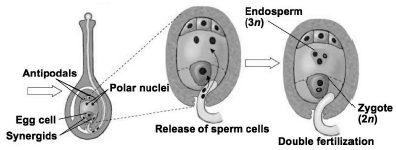
The fusion of this nucleus with the second male gamete is known as triple fusion. The triple fusion nucleus is called endosperm nucleus because it develops into endosperm. Endosperm is a nutritive tissue meant for the development of the embryo. The process of fusion of a male gamete with egg and the other gamete with secondary nucleus is known as double fertilization.
POST FERTILIZATION CHANGES :
- The ovule develops into seed.
- The integuments of the ovule develop into seed coats.
- The ovary enlarges and develops into fruit.
REPRODUCTION IN HUMAN BEINGS
MALE REPRODUCTIVE SYSTEM
The male reproductive system in human beings is composed of following parts:
Testis: There is a pair of testes; which lie in a skin pouch; called scrotum. Scrotum is suspended outside the body; below the abdominal cavity. This helps in maintaining the temperature of testes below the body temperature. This is necessary for optimum sperm production. Testis primarily serves the function of sperm production. Sperms are the male gametes. Apart from that, testis also produces testosterone. Testosterone is also called the male hormone, as it is responsible for developing certain secondary sexual characters in boys.
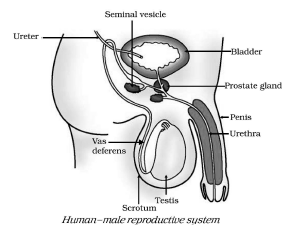
Vas Deferens: Vas deferens is the tube which carries sperms to the seminal vesicle.
Seminal Vesicle: This is the place where sperms are stored. Secretions from the seminal vesicle and prostate gland add up to make the semen.
Penis: It is a muscular organ which serves the genitor-urinary functions. The urethra works as the common passage for urine as well as for sperms.
FEMALE REPRODUCTIVE SYSTEM
The female reproductive system in human beings is composed of following parts:
Uterus: This is pear-shaped hollow muscular organ. Uterus is the place where the embryo gets implanted and develops into a newborn baby. The wall of the uterus provides safety and
nutrition to the growing foetus.
Fallopian Tubes: One fallopian tube comes out from each side at the top of the uterus. The fallopian tubes end in finger-like structures; called flimbriae. Fertilization happens in the
fallopian tube

Ovary: There are two ovaries; one near each fallopian tube. Ovary produces the eggs or the female gametes. All the eggs are produces by the ovary when the female child is still in the womb. One egg matures in each ovulation cycle and is released from the ovary. The egg is caught by the flimbriae and transferred to the fallopian tube.
Vagina: The cervix (mouth of the uterus) opens into the vagina. Vagina is a muscular tube-like organs; which serves as the passage for the sperms and also as the canal during the child birth.
PUBERTY
Human beings are complex animals and hence there is a distinct phase in their life cycle which marks the onset and attainment of sexual maturity. This period is called puberty. It usually starts at around 10 – 11 years of age in girls and at around 12 – 13 years of age in boys. It usually ends at around 18th year of age in girls and at around 19th year of age in boys. Since the years during puberty end in ‘teens’; hence this phase is also called teenage. Changes in Boys during Puberty: The boys suddenly grow in height dramatically. Voice becomes deep and the Adam’s apple becomes prominent. Shoulders become broad and body becomes muscular. Facial hairs begin to grow. Hairs also grow under the armpit and in the pubic region.
Changes in Girls during Puberty: The voice becomes thin. Shoulders and hip become rounded. Breasts get enlarged. Hairs grow under the armpit and in the pubic region.
Sexual Dimorphism: The physical dissimilarities in the male and female of a species which give them different appearances is called sexual dimorphism.
Secondary Sexual Characters: Features which highlight sexual dimorphism are called secondary sexual characters.
Menstruation: Menstruation is a trait which is unique to humans and some primates. During each ovulation cycle, the uterus prepares itself in anticipation of a possible pregnancy. The uterine wall develops an additional lining. When the egg is not fertilized, it gets disintegrated and so does the additional lining in the uterine wall. The fragments of disintegrated tissues are shed; along with blood. This is observed in the form of bleeding through the vagina which can last from 3 to 7 days. The whole sequence of events during an ovulation cycle is called menstrual cycle. The bleeding which occurs for few days is called menstruation. The first menstrual flow is called menarche and the last menstrual flow (which happens in the late 40s) is called menopause.
REPRODUCTIVE HEALTH
Human beings are different than other animals because they have the power of thinking. They have to obey certain moral values and need to behave sensibly in most of the aspects of life. Beginning of puberty does not mean that a person is psychologically ready for the process of reproduction. For a human being, reproduction involves more than just producing an offspring. As any act of sex has the potential of fertilization, so taking care of contraception becomes important. Moreover, the act of sex also has the potential of creating many sexually transmitted diseases. Examples of STDs are; gonorrhea, Herpes, syphilis, AIDS, Hepatitis B. AIDS and Hepatitis B are incurable till date. Even the curable STDs are potential dangerous; not only physically but also psychologically.
Reproductive health involves preventing the chances of STDs and preventing unwanted children. Reproductive health means a couple should be able to enjoy the reproductive phase of its life ; without taking the burden of gigantic family.
Question. How is the process of pollination different from fertilisation?
Answer:

Question. What is the role of the seminal vesicles and the prostate gland?
Answer: Secretions from seminal vesicles and prostate gland provide nutrition to the sperms and make their transport easier by providing them a fluid medium.
Question. What are the changes seen in girls at the time of puberty?
Answer: Changes seen in girls at the time of puberty are as follows:
(i) Growth of hair in armpits and public region.
(ii) Mammary glands (breast) develop and hips broaden.
(iii) Uterus, vagina, Fallopian tube enlarge and pelvis widens. Menstruation and ovulation also starts.
Question. How does the embryo get nourishment inside the mother’s body?
Answer: The embryo gets nutrition from the mothers blood with the help of special tissue called placenta. This is a disc-like tissue which develops between the uterine wall and embryo. It has villi on embryo side of the tissue. On the mothers side are blood spaces which the villi. This gives a large surface area for oxygen and glucose to pass from the mother to the embryo.
Question. If a women is using a copper-T, will it help in protecting her from sexually transmitted diseases?
Answer: No, copper-T does not prevent the transmission of sexually transmitted diseases. Copper-T only prevents implantation. The only safe method used to prevent the transmission of sexually transmitted diseases is the use of condoms.
Question. Asexual reproduction takes place through budding in
(a) amoeba.
(b) yeast.
(c) plasmodium.
(d) leishmania.
Answer: yeast
Asexual reproduction in Hydra and yeast takes place by budding.
Question. Which of the following is not a part of the female reproductive system in human beings?
(a) Ovary
(b) Uterus
(c) Vas deferens
(d) Fallopian tube
Answer: Vas deferens
Vas deferens is a part of male reproductive system in human.
Question. The anther contains
(a) sepals.
(b) ovules.
(c) carpel.
(d) pollen grains.
Answer: pollen grains
Anther is the female reproductive part in plants. It contains pollen grains the first cell of male gametophyte .
Question. What are the advantages of sexual reproduction over asexual reproduction?
Answer: There are a number of advantages of sexual reproduction over asexual one. These include
(i) Sexual reproduction created variations which are useful for ensuring survival of species and species formation.
(ii) Two different individuals in a population would have quite different patterns of accumulated variations.
(iii) The desired phenotype can be promoted by sexual reproduction.
These advantages are not available with asexual reproduction.
Question. What are the functions performed by the testis in human beings?
Answer: Functions of testes
(i) Produce male sex cells-sperms.
(ii) Produce male sex hormone testosterone.
Question. Why does menstruation occur?
Answer: Menstruation occurs when the egg is not fertilised. Every month uterus prepares itself to receive a fertilised egg, to nourish the embryo its lining becomes thick and spongy. In case egg is not fertilised this lining breaks and discharged out of the body through the vagina in the form of blood.
Question. Draw a labelled diagram of the longitudinal section of a flower.
Answer:

PARTS
1. Petals (corolla)
- Brightly coloured.
- Attracts insects for pollination.
- Base contains nectary which produces nectar.
2. Sepals (calyx)
- Protect the flower while in bud.
- Generally green and serves to photosynthesize food.
3. Receptacle (thalamus)
- Base of the flower to which all parts are attached.
- In some cases, after fertilization become fleshy (apple).
4.Pistil (carpel)
- Female reproductive part of the flower, known as gynoecium.
- Comprises of stigma, style and ovary.
- Stigma is sticky and receives pollen during pollination.
- Style links stigma to the ovary. It is a elongated tube through which pollen tubes grow.
- Ovary contains ovules (female gametes), which develop into seeds.
5. Stamen
- Male reproductive part of the flower, known as androecium.
- Comprises of anther and filament.
- Anther is bilobed. Each lobe contains two pollen sacs which produce pollen grains.
- Filament is the stalk of the stamen that supports anther
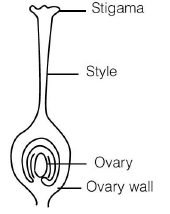
Question. What are the different methods of contraception?
Answer: The different methods of contraception are:
(i) Barrier Methods In barrier methods, the physical devices such as condoms and diaphragm are used. Condoms are used by male by putting rubber convering on the penis. They prevent sperms from meeting the egg.
(ii) Chemical Methods In the chemical methods, the females use pills-oral pills and vaginal pills. The oral pills contain hormones which stop ovaries from releasing ovum. The vaginal pills contain the chemicals called spermicides which kill the sperms.
(iii) Surgical Methods In males, a small portion of sperm duct is cut by surgical methods and the cut end is tied properly (vasectomy). This prevents the sperms from coming out. In females, a small part of the oviduct is cut and tied (tubectomy). This prevents the egg from entering the oviduct.
Question. How are the modes for reproduction different in unicellular and multicellular organisms?
Answer: Unicellular organisms are made up of only single cell, in which all the functions are performed by the single cell. So, reproduction is done by simple, asexual methods but in multicellular organisms various cells perform different functions. So, production of all these specialised cells/tissues is required and simple methods for reproduction are insignificant.
Question. How does reproduction help in providing stability to populations of species?
Answer: Reproduction leads to certain variations in the characteristics of the offspring. This may allow organism to exist in diverse habitats and niches. Certain variations present in the individuals of certain population may enable the individuals to survive those unfavourable conditions. Organism with such favourable traits transmit the characters to their offsprings, thereby providing stability to the population of a species.
Question. What could be the reasons for adopting contraceptive methods?
Answer: The reasons for adopting contraceptive methods are:
(i) To avoid frequent pregnancies, which in turn helps in population control
(ii) To prevent the spread of sexually transmitted diseases.
